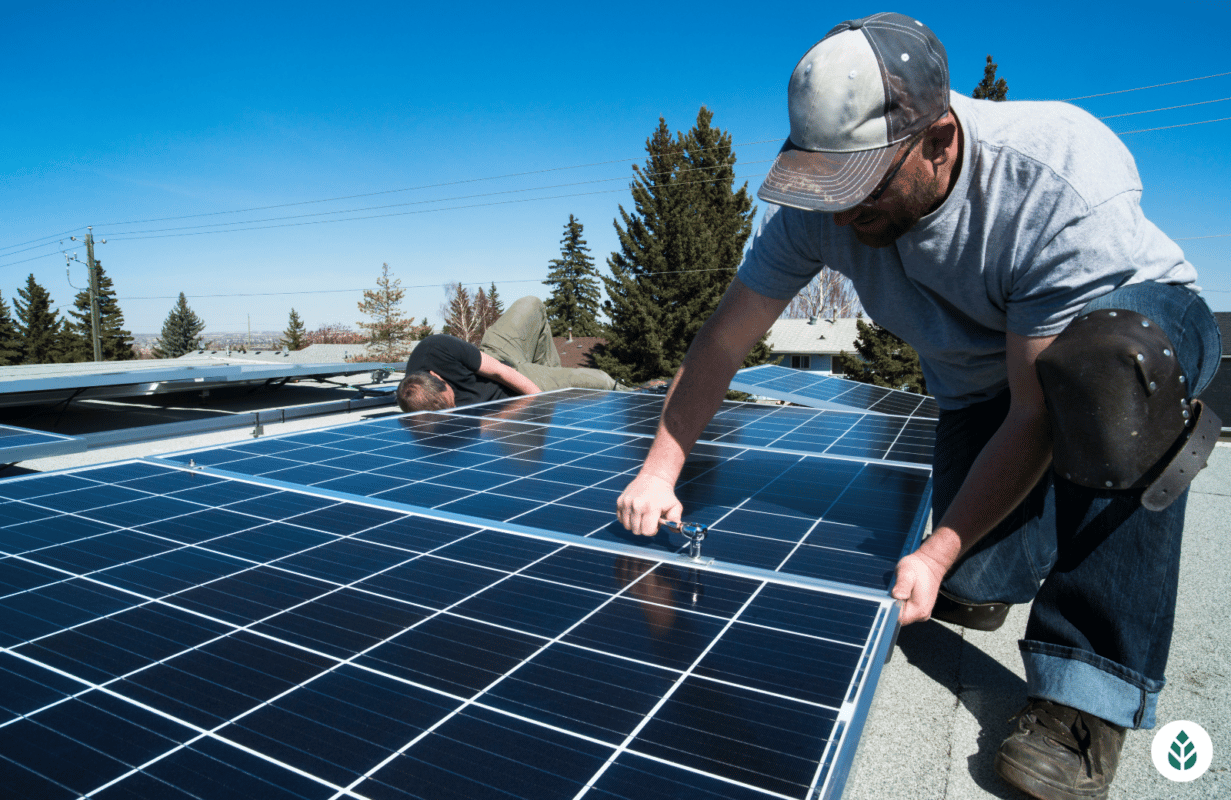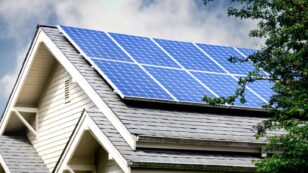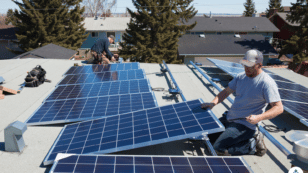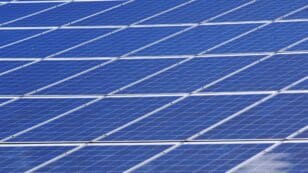

What Are Solar Panels Made Of (How Are They Made?)
Here’s what we’ll go over in this article:
- Which materials are used to make solar panels
- Why certain materials are used
- How solar panels are manufactured
- How eco-friendly the solar manufacturing process is
Each product and or company featured here has been independently selected by the writer. You can learn more about our review methodology here. If you make a purchase using the links included, we may earn commission.
What Are Solar Panels Made Of?
When you come across a solar panel, it may simply look like a single comprehensive block, but the truth is that solar panels are made of a bevy of chemical components and materials, each crucial to the effective and efficient conversion of solar light into usable electricity.
To start, virtually all solar photovoltaic (PV) panels use crystalline silicon wafers as the main component material. Silicon is used to create semiconductors for about 95% of all solar panels on the market today, with the other 5% using experimental and in-development technologies like organic photovoltaic cells.
The semiconductors created for solar panels are what create the electricity: upon interaction with sunlight, the electrons in this material get knocked loose, which is the basis of electricity. This process is called the photovoltaic effect and it’s how solar panels work to generate power.
Of course, the solar PV cells won’t be able to power your home without the rest of the operational components, including glass, plastic, metal and wiring. Solar panels are typically covered by a layer of glass and an anti-reflective coating to protect the sensitive silicon solar cells while still letting the light through.
The whole arrangement is supported by a plastic/polymer frame for installation on a rooftop or in a ground-mounted solar system. As with any modern and advancing technology, particularly in the energy space, solar panels come in many variations of styles, sub-components and designs.
The most common types of solar panels are monocrystalline solar panels, polycrystalline solar panels and thin-film solar panels:
- Monocrystalline silicon panels are made from a single crystal. They are the most efficient solar panels, but they’re also the most expensive.
- Polycrystalline silicon solar cells are made from multiple silicon crystals melded together. They’re not quite as high-efficiency as monocrystalline panels, but they’re a more budget-friendly rooftop solar option.
- Thin-film solar cells are made from amorphous silicon, which makes them the most flexible solar panels but also the least efficient.

SunPower

Nationwide Service
Average cost
Pros
- Most efficient panels on the market
- National coverage
- Cradle to Cradle sustainability certification
- Great warranty coverage
Cons
- Expensive
- Customer service varies by local dealer
SunPower designs and installs industry-leading residential solar and storage solutions across all 50 states. With a storied history of innovation dating back to 1985, no other company on this list can match SunPower’s experience and expertise.
SunPower earns its position as the top national installer on our list for a handful of reasons: It installs the most efficient solar technology on the residential market, offers the most expansive service area and backs its installations with a warranty well above the industry standard. All the while, SunPower pioneers sustainability efforts within the industry.
If that weren’t enough, SunPower systems come packaged with products all manufactured in-house by its sister company, Maxeon. This means that your panels, solar cells, inverters, battery and EV chargers are designed to work together and are all covered under the same warranty.
SunPower’s biggest downside? Its high-efficiency panels are considerably more expensive than most of its competitors’ products. However, its powerful panels are workhorses that make up for the initial cost with more backend production (think about this like spending more money for a car that gets more miles per gallon).
Facts and Figures: SunPower
| EcoWatch Rating |
|---|
| Better Business Bureau (BBB) Rating |
| Year Founded |
| Average Cost ($-$$$$$) |
| Solar Services |
| Brands of Solar Equipment Offered |
| Warranty Coverage |
| 5 |
| A+ |
| 1985 |
| $$$$ |
| Solar Panels, Solar Batteries, EV Chargers, System Monitoring |
| SunPower Panels |
| 25-year all-inclusive warranty |

Blue Raven Solar

Regional Service
Average cost
Pros
- Industry-leading in-house financing
- Competitive pricing
- Excellent reputation
Cons
- Doesn't offer solar batteries (coming 2022)
We like Blue Raven Solar because it understands that, for most homeowners, the cost of solar presents the biggest barrier to entry.
For that reason, Blue Raven Solar developed an innovative solar financing plan that offers in-house, flexible, zero-money-down options. The results speak for themselves, as Blue Raven Solar is now one of the fastest-growing solar companies in the nation and was recently acquired by SunPower. Its BluePower Plus+ plan (exclusive to Blue Raven) mimics the flexible structure of a lease while still providing the greatest benefits of owning your system.
Eligible homeowners enjoy 18 months of solar power before having to pay their first bill. When coupled with the federal solar investment tax credit (ITC), the initial energy savings can offset more than a third of the overall cost of a system before requiring a dollar down.
In contrast, other installers can only offer similar financing through solar leases, PPAs or third-party providers (such as Mosaic or Sunlight). Third-party loan providers can complicate the process, while opting for a loan or PPA will disqualify you from some of solar’s biggest benefits (additional property value, federal solar tax credit and local solar incentives).
Facts and Figures: Blue Raven Solar
| EcoWatch Rating |
|---|
| Better Business Bureau (BBB) Rating |
| Year Founded |
| Average Cost ($-$$$$$) |
| Solar Services |
| Brands of Solar Equipment Offered |
| Warranty Coverage |
| 4.5 |
| A+ |
| 2014 |
| $$ |
| Solar Panels, System Monitoring |
| Trina Solar, Canadian Solar, SolarEdge, Silfab, SunPower |
| 25-year manufacturer warranty; 10-year workmanship warranty, 2-year production guarantee |
Why Are Solar Panels Made With Silicone?
With silicone being the predominant material used to create solar panels, the natural question to ask is: why? Silicone has been used as the semiconductor material of a solar PV panel for the majority of the solar industry’s history.
When investigating all possible materials on the periodic table, developers of early and modern solar panels all found that silicone actually boasted a number of ideal properties that made it the perfect candidate as this semiconductor material:
- Silicone is abundantly available and affordable as an elemental material, making it good for large-scale systems.
- Chemically and electronically speaking, silicone is quite easy to optimize for the photovoltaic effect that efficiently converts sunlight into electricity.
- As a component material, silicone is recognized as having a long lifespan, making the investment in solar panels even more fruitful.
You can get a free, no-obligation estimate from a leading solar company in your area by clicking below.
How Are Solar Panels Made?
Because of how many solar panels are needed to keep up with the growing global demand for new solar installations, the manufacturing process has become quite streamlined and standardized.
Solar manufacturers start by creating the silicon cells, a process that involves melting the silicone material down and mixing it with supportive elements. They then create sheets of material that can be cut and turned into the component cells. This part of the process typically entails mass production and laser cutting to expedite manufacturing.
The finished cells are then protected with a layer of material such as glass or plastic. Once the solar cells are created, they need to be connected together in the right size, shape and configuration. To do this, manufacturers solder them to the base of a solar panel, which is made of a conductive metal.
The base houses the cells and also transfers the electricity they’re generating to a single location, whether it’s being sent into a building, into a local power grid or elsewhere.
At that point, all that’s left is to connect the solar module to an outer polymer frame, which holds the panel and insulates the electrical components, covering everything with a protective layer of glass.
Finally, manufacturers box the panels and send them out to installers.
Are Solar Panels Environmentally Friendly to Make?
While solar power is often held up as a beacon of clean energy in a world rapidly succumbing to climate change, detractors will point out that solar panel manufacturing has its own environmental considerations.
As solar panel technology has improved over the last several decades, the manufacturing process has continued to become less polluting, as shown in an academic study that found “strong downward trends of environmental impact” from solar panel production between 1975 and 2015. That rate of improvement hasn’t stalled in recent years, and identifying the most environmentally friendly materials and production processes remains a top priority of all major solar producers.
Even further, end-of-life considerations for solar panels are being actively incorporated into the solar panel lifecycle, with manufacturers developing ways to recycle panels and their material components to further minimize their impact. With that said, there is no such thing as a free lunch.
The manufacturing of any product requires energy and resources, meaning the process inherently adds carbon dioxide to the atmosphere — exactly what that renewable energy is seeking to minimize. While it’s true that solar panels have an environmental cost to their production, so too do the construction of power plants and wind turbines; the extraction and burning of fossil fuels; and any other method to create useful energy.
But with solar panels having a lifetime of 25 years or more, that environmental impact is spread over a long period, while the actual electricity production requires zero fuel. On a per-kilowatt-hour basis over the course of a solar panel’s lifetime, the net impact is much lower than almost any other energy source, and that impact is getting even smaller with the continued improvement to technologies, supply chains and recycling programs.
Is Solar Energy Right for You?
As power companies seek to address climate change and eco-conscious energy consumers recognize the benefits of generating their own electricity, solar energy is becoming a much more common source of electricity.
After being merely a blip on the radar as recently as 2010, U.S. solar energy capacity has grown by 50 times in the past decade to reach nearly 76 gigawatts, generating enough energy to power 19 million average households. Most people have observed this trend toward clean energy, seeing neighbors buy solar panels, coming across solar installations on top of a local business or even driving by a full-sized solar farm. But is solar a good choice for your home?
For many homeowners, the decision comes down to cost.
You can get a free, no-obligation estimate from a leading solar company in your area by clicking below.
Frequently Asked Questions: What Are Solar Panels Made Of?
Solar panels are composed of numerous solar cells, a set of wiring to connect those solar cells to a conductive material base, a glass or plastic protective casing for both individual cells and the whole panel, and a frame used to house all of these components. The material components typically include silicone or another semiconductor material, metal, plastic or glass, and wiring apparatuses.
Solar farms do not produce any emissions, noise, pollution or other outward hazards. They also won’t impact the level of sunlight experienced by those living near them. The hazardous materials sometimes discussed regarding solar panels are safely contained within the panels themselves and are only a concern when determining how to dispose of or recycle those panels, so they pose no danger to those living nearby.
Some of the metal and chemical materials in a solar panel can be toxic and hazardous if exposed to people, including panels that may have cadmium telluride, arsenic, hexavalent chromium coatings, copper or selenium. In typical operation, though, these materials are securely contained and don’t pose any direct risk.
The back of a solar panel, known as the backsheet, is made of a polymer or plastic combination. It provides insulation from the electrical components of the panel.
Comparing authorized solar partners
-
- Most efficient panels on the market
- National coverage
- Cradle to Cradle sustainability certification
- Great warranty coverage
- Expensive
- Customer service varies by local dealer
A+Best National Provider1985SunPower Panels25-year all-inclusive warranty
Having trouble deciding? Click below and use our process to receive multiple quotes instead:

 233k
233k  41k
41k  Subscribe
Subscribe 




